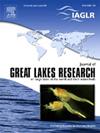Phosphorus loading to nearshore waters from legacy septic system groundwater plumes in a Great Lakes coastal community
IF 2.4
3区 环境科学与生态学
Q3 ENVIRONMENTAL SCIENCES
引用次数: 0
Abstract
High phosphorus (P) loads to the Laurentian Great Lakes contribute to eutrophication, harmful algal blooms, and hypoxia. Groundwater impacted by wastewater effluent from household septic systems, common in coastal communities, is a recognized P source to nearby lakes. However, the long-term impact of neighbourhood-scale septic system decommissioning (i.e., conversion to sewer connections) on this P loading is not well understood or quantified. The objective of this study was to investigate long-term P loading to Nottawasaga Bay from groundwater plumes of decommissioned septic systems in the coastal community of Wasaga Beach. Detailed groundwater sampling characterized a legacy P plume from a septic system decommissioned 35 years ago, revealing elevated soluble reactive phosphorus concentrations extending over 40 m and reaching the shoreline. Sorption and dispersion parameters required for neighbourhood-scale modeling were derived by simulating this persistent, long but thin P plume using a numerical model. Numerical simulations of P plumes from > 800 septic systems, 0.01–1.6 km from the shoreline and active < 65 years before decommissioning, revealed P mass discharge to the lake started after ∼ 30 years and will continue for > 4000 years. Relatedly, the extended P transport meant the annual mass discharge rate to the lake was consistently < 1.3 % of the annual mass input rate from septic systems to the aquifer, though it varied over time according to the septic systems’ distance from shore. These findings highlight the long-term view required in accounting for decommissioned septic systems in P management strategies to protect lake water quality.
求助全文
约1分钟内获得全文
求助全文
来源期刊

Journal of Great Lakes Research
生物-海洋与淡水生物学
CiteScore
5.10
自引率
13.60%
发文量
178
审稿时长
6 months
期刊介绍:
Published six times per year, the Journal of Great Lakes Research is multidisciplinary in its coverage, publishing manuscripts on a wide range of theoretical and applied topics in the natural science fields of biology, chemistry, physics, geology, as well as social sciences of the large lakes of the world and their watersheds. Large lakes generally are considered as those lakes which have a mean surface area of >500 km2 (see Herdendorf, C.E. 1982. Large lakes of the world. J. Great Lakes Res. 8:379-412, for examples), although smaller lakes may be considered, especially if they are very deep. We also welcome contributions on saline lakes and research on estuarine waters where the results have application to large lakes.
 求助内容:
求助内容: 应助结果提醒方式:
应助结果提醒方式:


